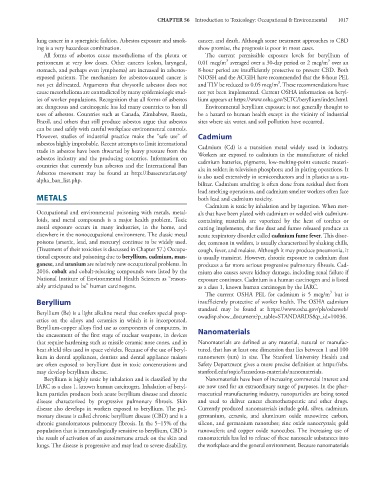Page 1031 - Basic _ Clinical Pharmacology ( PDFDrive )
P. 1031
CHAPTER 56 Introduction to Toxicology: Occupational & Environmental 1017
lung cancer in a synergistic fashion. Asbestos exposure and smok- cancer, and death. Although some treatment approaches to CBD
ing is a very hazardous combination. show promise, the prognosis is poor in most cases.
All forms of asbestos cause mesothelioma of the pleura or The current permissible exposure levels for beryllium of
3
3
peritoneum at very low doses. Other cancers (colon, laryngeal, 0.01 mcg/m averaged over a 30-day period or 2 mcg/m over an
stomach, and perhaps even lymphoma) are increased in asbestos- 8-hour period are insufficiently protective to prevent CBD. Both
exposed patients. The mechanism for asbestos-caused cancer is NIOSH and the ACGIH have recommended that the 8-hour PEL
3
not yet delineated. Arguments that chrysotile asbestos does not and TLV be reduced to 0.05 mcg/m . These recommendations have
cause mesothelioma are contradicted by many epidemiologic stud- not yet been implemented. Current OSHA information on beryl-
ies of worker populations. Recognition that all forms of asbestos lium appears at https://www.osha.gov/SLTC/beryllium/index.html.
are dangerous and carcinogenic has led many countries to ban all Environmental beryllium exposure is not generally thought to
uses of asbestos. Countries such as Canada, Zimbabwe, Russia, be a hazard to human health except in the vicinity of industrial
Brazil, and others that still produce asbestos argue that asbestos sites where air, water, and soil pollution have occurred.
can be used safely with careful workplace environmental controls.
However, studies of industrial practice make the “safe use” of Cadmium
asbestos highly improbable. Recent attempts to limit international Cadmium (Cd) is a transition metal widely used in industry.
trade in asbestos have been thwarted by heavy pressure from the Workers are exposed to cadmium in the manufacture of nickel
asbestos industry and the producing countries. Information on cadmium batteries, pigments, low-melting-point eutectic materi-
countries that currently ban asbestos and the International Ban als; in solder; in television phosphors; and in plating operations. It
Asbestos movement may be found at http://ibasecretariat.org/ is also used extensively in semiconductors and in plastics as a sta-
alpha_ban_list.php.
bilizer. Cadmium smelting is often done from residual dust from
lead smelting operations, and cadmium smelter workers often face
METALS both lead and cadmium toxicity.
Cadmium is toxic by inhalation and by ingestion. When met-
Occupational and environmental poisoning with metals, metal- als that have been plated with cadmium or welded with cadmium-
loids, and metal compounds is a major health problem. Toxic containing materials are vaporized by the heat of torches or
metal exposure occurs in many industries, in the home, and cutting implements, the fine dust and fumes released produce an
elsewhere in the nonoccupational environment. The classic metal acute respiratory disorder called cadmium fume fever. This disor-
poisons (arsenic, lead, and mercury) continue to be widely used. der, common in welders, is usually characterized by shaking chills,
(Treatment of their toxicities is discussed in Chapter 57.) Occupa- cough, fever, and malaise. Although it may produce pneumonia, it
tional exposure and poisoning due to beryllium, cadmium, man- is usually transient. However, chronic exposure to cadmium dust
ganese, and uranium are relatively new occupational problems. In produces a far more serious progressive pulmonary fibrosis. Cad-
2016, cobalt and cobalt-releasing compounds were listed by the mium also causes severe kidney damage, including renal failure if
National Institute of Environmental Health Sciences as “reason- exposure continues. Cadmium is a human carcinogen and is listed
ably anticipated to be” human carcinogens. as a class 1, known human carcinogen by the IARC.
3
The current OSHA PEL for cadmium is 5 mcg/m but is
Beryllium insufficiently protective of worker health. The OSHA cadmium
standard may be found at https://www.osha.gov/pls/oshaweb/
Beryllium (Be) is a light alkaline metal that confers special prop- owadisp.show_document?p_table=STANDARDS&p_id=10036.
erties on the alloys and ceramics in which it is incorporated.
Beryllium-copper alloys find use as components of computers, in Nanomaterials
the encasement of the first stage of nuclear weapons, in devices
that require hardening such as missile ceramic nose cones, and in Nanomaterials are defined as any material, natural or manufac-
heat shield tiles used in space vehicles. Because of the use of beryl- tured, that has at least one dimension that lies between 1 and 100
lium in dental appliances, dentists and dental appliance makers nanometers (nm) in size. The Stanford University Health and
are often exposed to beryllium dust in toxic concentrations and Safety Department gives a more precise definition at https://ehs.
may develop beryllium disease. stanford.edu/topic/hazardous-materials/nanomaterials.
Beryllium is highly toxic by inhalation and is classified by the Nanomaterials have been of increasing commercial interest and
IARC as a class 1, known human carcinogen. Inhalation of beryl- are now used for an extraordinary range of purposes. In the phar-
lium particles produces both acute beryllium disease and chronic maceutical manufacturing industry, nanoparticles are being tested
disease characterized by progressive pulmonary fibrosis. Skin and used to deliver cancer chemotherapeutic and other drugs.
disease also develops in workers exposed to beryllium. The pul- Currently produced nanomaterials include gold, silver, cadmium,
monary disease is called chronic beryllium disease (CBD) and is a germanium, ceramic, and aluminum oxide nanowires; carbon,
chronic granulomatous pulmonary fibrosis. In the 5–15% of the silicon, and germanium nanotubes; zinc oxide nanocrystals; gold
population that is immunologically sensitive to beryllium, CBD is nanowafers; and copper oxide nanocubes. The increasing use of
the result of activation of an autoimmune attack on the skin and nanomaterials has led to release of these nanoscale substances into
lungs. The disease is progressive and may lead to severe disability, the workplace and the general environment. Because nanomaterials

